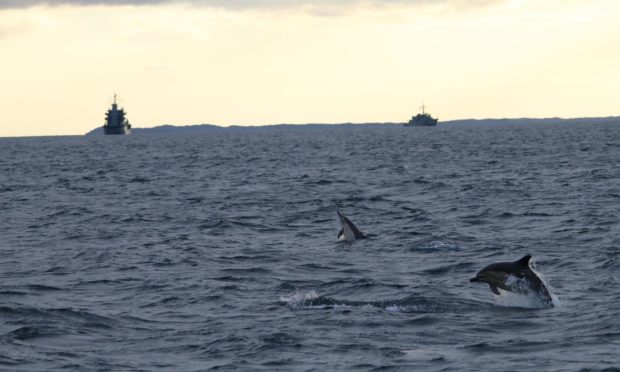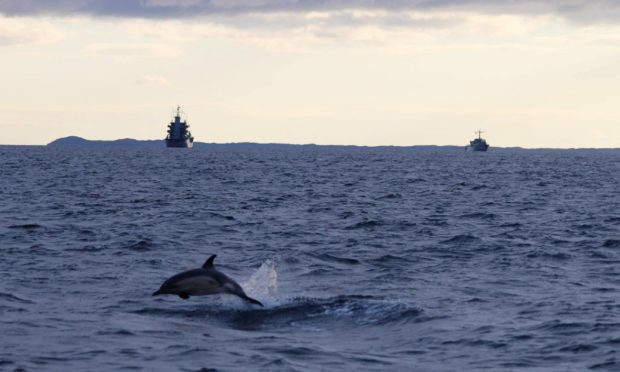A marine conservation charity fears a huge multinational military exercise off the north and west coast will have a significantly greater impact this year on whales, dolphins and porpoises.
Exercise Joint Warrior, the largest military exercise in Europe, takes place annually in spring and autumn involving nearly 4,000 military personnel from 14 countries.
It involves 58 aircraft and 16 warships taking part in airborne assaults, amphibious landings, evacuations and live-fire exercises.
The Hebridean Whale and Dolphin Trust (HWDT) has long-standing concerns about the effect the war exercises have on cetaceans.
But it says this year Joint Warrior is being held later than usual in the spring and earlier in the autumn.
More sightings in May and September
HWDT, which has been running monitoring surveys to coincide with Joint Warrior since 2009, said its long-term data shows consistently higher sighting rates of several species in mid-May compared to early April when the exercises normally run.
This also applies to the proposed autumn dates, with higher sighting rates seen in September compared to October.
The Mull-based trust said whales, dolphins and porpoises are reliant on using sound underwater to navigate, find food and communicate, while they are also sensitive to underwater noise.
Military sonar used during the operations produces an intense loud noise that can disturb and cause injury and mass-strandings of cetaceans, it claims.
HWDT has questioned how the exercises are allowed to take place within and near protected areas and known “hot-spots” for cetaceans and said it is disappointed Joint Warrior is going ahead.
Lauren Hartny-Mills, the trust’s science and conservation manager, said: “Running the Joint Warrior exercises in May and September is likely to have a greater impact on cetaceans.”
She said there is concern for the wide variety of cetaceans species present at this time of year, including minke whales, common dolphins and resident pods of dolphins and harbour porpoises.
Exercises will have greater impact on cetaceans
Lauren Hartny-Mills
“We plan to continue to discuss this with the MoD and statutory nature conservation bodies to better understand the impact and make sure the protection that cetaceans have in Scotland is meaningful and harmful activities do not take place in these areas.”
The trust is also asking people to contribute to its long-term monitoring of military exercises by reporting any sightings of whales, dolphins, porpoises or basking sharks through Whale Track.
An MoD spokesman said: “The Royal Navy takes its environmental responsibilities very seriously and continues to work with the relevant UK authorities to ensure all practical measures required to reduce environmental risk and comply with legislation are taken.
“A necessary series of safety checks is observed and an environmental risk assessment is carried out before any underwater task is undertaken by MoD, to minimise any potential risk to marine life.
Avoidance action should animals be detected
“Where at all possible, operators take avoidance actions should animals be detected before or during sonar operations. Our precautionary practices are similar to those used in other marine industries and are regularly reviewed by statutory bodies to ensure they reflect the latest understanding of the marine environment and the effects of sound on it.
“To remain effective elements of UK defence, Royal Navy units need to operate flexibly in locations around the UK and the world.”
Joint Warrior is a UK-led war exercise where the Royal Navy, Royal Air Force and British Army are joined by forces from other Nato and allied forces.
The exercise simulates a range of scenarios, including crisis and conflict situations that could be realistically encountered in operations, such as territory disputes, terrorist activity and piracy.
Last year HWDT won the RSPB Nature of Scotland Coasts and Waters Award for its Hebridean Whale Trail which stretches from Cape Wrath in Sutherland to the Clyde.

